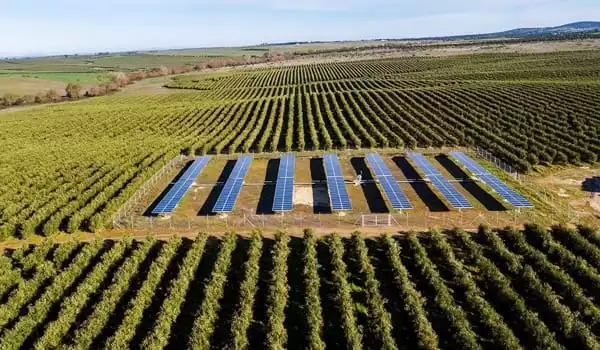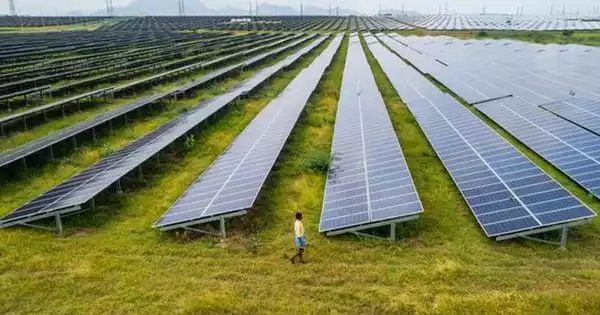P. Ramesh’s 22-year-old groundnut farm was losing money in 2007. Ramesh was applying a cocktail of pesticides and fertilizers across his 2.4 hectares in the Anantapur area of southern India, as was (and still is) the usual in most of India. Farming is difficult in this desert-like region, which receives less than 600 millimeters of rain most years.
“I lost a lot of money cultivating groundnuts using chemical agricultural methods,” Ramesh, who goes by the first letter of his father’s name followed by his first name, as is customary in many regions of southern India, adds. The chemicals were costly, and his yields were minimal.
The chemicals were then removed in 2017. “My productivity and income have increased since I started using regenerative agricultural approaches like agroforestry and natural farming,” he says.
Ramesh raised his revenues enough to acquire more land, enlarging his allotment to roughly four hectares, thanks to the nonprofit Accion Fraterna Ecology Centre in Anantapur, which helps with farmers who wish to practice sustainable farming. Ramesh, like hundreds of other farmers across India practicing regenerative farming, has been able to replenish his depleted soil while his new trees help keep carbon out of the atmosphere, thus playing a small but significant contribution in lowering India’s carbon footprint. Recent studies have shown that the carbon sequestration potential of agroforestry is as much as 34 percent higher than standard forms of agriculture.
Pravinbhai Parmar, 36, of Dhundi village in Gujarat, more than 1,000 kilometers from Anantapur, is utilizing his rice farm to mitigate climate change. He no longer uses diesel to operate his groundwater pumps after installing solar panels. And he has an incentive to pump only what he needs because he may sell the excess electricity.
According to a 2020 article in Carbon Management, if all farmers like Parmar switched to solar, India’s carbon emissions, which are 2.88 billion metric tons per year, could be reduced by 45 million to 62 million tons per year. So far, approximately 250,000 solar irrigation pumps have been installed in the country, out of an estimated 20 million to 25 million total groundwater pumps.
When we talk about climate-smart agriculture, we mostly talk about how it has decreased emissions. The largest challenge climate change poses, particularly to farmers. Any agricultural strategy that assists farmers in dealing with uncertainty improves resistance to climate change.
Shilp Verma
Growing food while reducing already significant greenhouse gas emissions from agricultural techniques is tough for a country that must provide for what will soon be the world’s largest population. Agriculture and livestock now account for 14% of India’s total national greenhouse gas emissions. When the electricity needed by agriculture is factored in, the percentage rises to 22 percent.
Ramesh and Parmar are part of a small but growing number of farmers who are receiving aid from government and nongovernmental organizations to modify their farming practices. It will take some time to reach the estimated 146 million others who cultivate 160 million hectares of arable land in India. But these farmers’ success stories are testimony that one of India’s largest emitting sectors can change.
Feeding the soil, sustaining farmers
Farmers in India are already suffering the effects of climate change, dealing with dry spells, irregular rainfall, and more frequent heat waves and tropical storms. “When we talk about climate-smart agriculture, we mostly talk about how it has decreased emissions,” says Indu Murthy, sector leader for climate, environment, and sustainability at the Bengaluru-based Center for Study of Science, Technology, and Policy. However, she believes that such a system will assist farmers in “coping with unanticipated shifts and weather patterns.”
In many ways, this is the principle that underpins a wide range of sustainable and regenerative farming techniques classified as agroecology. Natural farming and agroforestry are two components of this system that are finding more and more takers across India’s varied landscapes, says Y.V. Malla Reddy, director of Accion Fraterna Ecology Centre.

Reddy’s organization has assisted over 60,000 Indian agricultural households in practicing natural farming and agroforestry on almost 165,000 hectares. The calculation of their work’s soil carbon sequestration capacity is continuing. However, according to a 2020 assessment by India’s Ministry of Environment, Forest, and Climate Change, these farming practices can help India accomplish its target of having 33 percent forest and tree cover by 2030 to meet its carbon sequestration pledges under the Paris climate agreement.
In comparison to other options, regenerative agriculture is a reasonably inexpensive technique to reduce carbon dioxide in the environment. According to a 2020 analysis published in Nature Sustainability, regenerative farming costs $10 to $100 per ton of carbon dioxide removed from the atmosphere, compared to $100 to $1,000 per ton of carbon dioxide for systems that mechanically remove carbon from the air. Such farming not only benefits the environment, but it is also likely that farmers’ wages would grow when they transition to regenerative agriculture, according to Reddy.
Growing solar
Establishing agroecology practices to see an effect on carbon sequestration can take years or decades. But using renewable energy in farming can quickly reduce emissions. For this reason, the nonprofit International Water Management Institute, IWMI, launched the program Solar Power as Remunerative Crop in Dhundi village in 2016.
“The largest challenge climate change poses, particularly to farmers,” says Shilp Verma, an IWMI researcher of water, energy, and food policies headquartered in Anand. “Any agricultural strategy that assists farmers in dealing with uncertainty improves resistance to climate change.” Farmers will have more cash to deal with unstable conditions if they can pump groundwater in a climate-friendly manner that simultaneously gives incentives to keep some water in the ground. “If you pump less, you can sell the excess energy to the grid,” he explains. Solar energy becomes a source of revenue.
Rice requires a lot of water to thrive, especially lowland rice, which is farmed on flooded terrain. According to the International Rice Research Institute, it takes approximately 1,432 liters of water to produce one kilogram of rice. According to the organization, irrigated rice receives an estimated 34 to 43 percent of the world’s total irrigation water. India is the world’s largest extractor of groundwater, accounting for 25% of total extraction. Carbon is released into the atmosphere as diesel pumps extract. Parmar and his other farmers used to have to buy that fuel to keep their pumps running.





